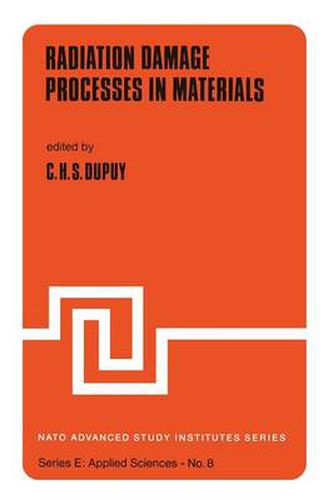Readings Newsletter
Become a Readings Member to make your shopping experience even easier.
Sign in or sign up for free!
You’re not far away from qualifying for FREE standard shipping within Australia
You’ve qualified for FREE standard shipping within Australia
The cart is loading…






This title is printed to order. This book may have been self-published. If so, we cannot guarantee the quality of the content. In the main most books will have gone through the editing process however some may not. We therefore suggest that you be aware of this before ordering this book. If in doubt check either the author or publisher’s details as we are unable to accept any returns unless they are faulty. Please contact us if you have any questions.
Thirty years ago, the sharp development of the nuclear phy- SlCS has given scope to some connected areas such as radiochemis try, radiobiology, radioprotection, radiation damages. In this last subject - damages induced by radiations in mate rials, the earlier studies are essentially connected to the me chanism of defect creation. Several workers, for instance, SEITZ (1949), DIENES and VINEYARD (1957), BILLINGTON and CRAWFORD (1961) have developed the first approach in the damage processes theories. In the 65th years a saturation effect occurs in the studies of the mechanisms and correlatively a strong development appears in the physics of the defect itself. If it is possible in many cases to study defects without a good ~nowledge of their origin many researchs, in particular in the field of defects induced by energetic heavy ions, needs a better understanding of the damage processes. The track phenomena for instance is of special interest in heavy ions problems, cosmic ray tracks in lunar and meteorite crystals or glasses are a good indicator of the solar activity. On the other hand, color centers, induced by energetic heavy ions in alkali-halides crystals, shown a quite different behaviour than those created by light particles, it is necessary to assume that the ionic bombardement creates centers in a well located re gion : a core around the path of the incident particle.
$9.00 standard shipping within Australia
FREE standard shipping within Australia for orders over $100.00
Express & International shipping calculated at checkout
This title is printed to order. This book may have been self-published. If so, we cannot guarantee the quality of the content. In the main most books will have gone through the editing process however some may not. We therefore suggest that you be aware of this before ordering this book. If in doubt check either the author or publisher’s details as we are unable to accept any returns unless they are faulty. Please contact us if you have any questions.
Thirty years ago, the sharp development of the nuclear phy- SlCS has given scope to some connected areas such as radiochemis try, radiobiology, radioprotection, radiation damages. In this last subject - damages induced by radiations in mate rials, the earlier studies are essentially connected to the me chanism of defect creation. Several workers, for instance, SEITZ (1949), DIENES and VINEYARD (1957), BILLINGTON and CRAWFORD (1961) have developed the first approach in the damage processes theories. In the 65th years a saturation effect occurs in the studies of the mechanisms and correlatively a strong development appears in the physics of the defect itself. If it is possible in many cases to study defects without a good ~nowledge of their origin many researchs, in particular in the field of defects induced by energetic heavy ions, needs a better understanding of the damage processes. The track phenomena for instance is of special interest in heavy ions problems, cosmic ray tracks in lunar and meteorite crystals or glasses are a good indicator of the solar activity. On the other hand, color centers, induced by energetic heavy ions in alkali-halides crystals, shown a quite different behaviour than those created by light particles, it is necessary to assume that the ionic bombardement creates centers in a well located re gion : a core around the path of the incident particle.